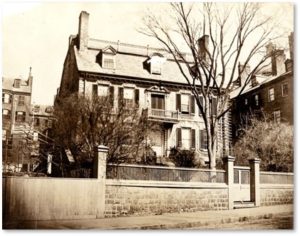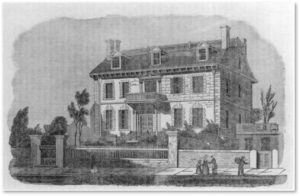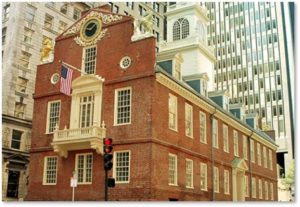John Hancock, prominent merchant, first signer of the Declaration of Independence, and first governor of Massachusetts under the state constitution, lived on Beacon Hill. In fact, a wing of the Massachusetts State House occupies what used to be his pasture. The Hancock Mansion has been gone for a long time but the front door remains and can be seen in Boston today.
Thomas Hancock’s Estate
Thomas Hancock, a wealthy Boston merchant, built his mansion—the first house to go up on the top of Beacon Hill—between 1734 and 1737. Back then, Beacon Hill was the boonies—farmland and woods in the country far from downtown Boston. Thomas Hancock didn’t acquire a neighbor until 1768, when the painter John Singleton Copley built a house further down the hill’s western slope.
Mr. Hancock owned a large tract that extended from today’s Joy Street on the west to Park Street on the east and from Beacon Street on the south almost to Derne Street on the north. Beacon Hill rose to its full height then and the farm went up its side to where the State House annex now stands.
The Georgian House
Joshua Blanchard built the three-story center-entry structure in the Georgian style from Quincy surface granite that was squared off and hammered. When completed, it was the first granite house in Boston. The façade stretched 56 feet long facing Beacon Street and a balcony projected over the entrance door, providing shelter from the elements.
The balcony door sported a pediment that ended in baroque volutes. Quoins of Braintree stone ornamented both corners and window openings..
A carved railing marked the edges of the mansion’s tiled gambrel roof. Three dormer windows projected from the roof. Both the balcony and the dormer windows offered a panoramic view of Boston Common—then still common pastureland—and out to Boston Harbor.
The Nephew Inherits
The John Hancock mansion was quite a sight in those days—easily the finest house in Boston—and it would still be a Freedom Trail attraction now, like the North End’s Paul Revere House. What happened to it?
Although Thomas and Lydia Hancock had no children of their own, they took in Thomas’s seven-year-old nephew, John, in 1744 after Thomas’s brother died. The boy moved from Braintree to Boston and lived in the Beacon Hill mansion while he attended Boston Latin School (1750) and Harvard College (1754).
Upon his graduation from Harvard, John Hancock joined his uncle’s merchant firm and took it over when Thomas Hancock died in 1764. He also inherited the house and estate, where he lived for the rest of his life.
The Inheritance
When John Hancock died in 1793, the city had expanded westward and the Beacon Hill neighborhood was becoming gentrified. The family sold off portions of the estate, including the land on which Charles Bulfinch built the new State House. Other parcels were sold for new homes as the State House attracted residents to Beacon Hill.
The house remained in the Hancock family, passing from his widow, Dorothy Hancock, to another nephew named John Hancock until his death in 1859. At that time, Governor Nathaniel Banks proposed that the city purchase the still-elegant mansion as the governor’s mansion.
A Failure to Act
Boston could have purchased the beautiful house from the Hancock heirs for $100,000—about $2,883,222 today.
But no. The rural districts in the Legislature opposed this expenditure. Another suggestion from the Hancock heirs to turn it into a museum also failed. With no action from the state, the heirs sold the house and land for $125,000 on February 13, 1863. The Hancock Mansion served as a museum of sorts for a few months while yet another scheme to relocate it across the street to Boston Common also went down to defeat. This time, the legislature worried about putting a structure in a public park and would not allocate $12,000 to cover the historic dwelling’s transfer. That’s about $252,570 today.
The Beginning of the End
It was the beginning of the end. In June of the same year, the house went up for sale at public auction and was purchased by William Dalrymple for $230, just $4,841 in today’s money. Mr. Dalrymple had 10 days to clean it out. Despite an enormous public outcry, the two men who had purchased the land demolished the Hancock Mansion in a matter of days.
Bostonians sought souvenirs of the structure, either purchasing them at auction, receiving them as gifts, or scavenging them even as the house was demolished. Pieces of the old structure were dispersed and disappeared. Some became part of museum collections around New England while others went into private hands.
The Hancock Mansion’s Front Door
The manor’s front door joined the collection of the Boston Museum on Tremont Street. The museum put the12-panel door, made of solid eastern white pine into storage and gave it to the Old State House in 1899.
In 2018, the Bostonian Society commissioned students from the North Bennet Street School to restore the door. The students also built a full-scale reproduction of the surrounding entryway, using only old photographs and illustrations for guidance. The entryway includes hand-carved brackets, wallpaper, wood columns, and timber frames.
The door knocker on the outside of the door was separated from its home of 126 years when it was given to Dr. Oliver Wendell Holmes, who used it on his own front entry. Returned to its rightful place, it now ornaments the Hancock Door once again.
Visiting the Hancock Door
Imagine the people who opened that door to enter the John Hancock Mansion in its heyday: The Sons of Liberty, the Marquis de Lafayette, George Washington, John Singleton Copley, French Admiral Charles d’Estaing, and British General Henry Clinton, among them.
You can see the Hancock Door in its restored glory in the Old State House Museum. Thanks to the inspired work of the North Bennet School Students, it’s easy to imagine yourself walking through it and standing in the company of those historical figures.
(The front steps are also still extant, but that is another blog post.)
A Faithful Reproduction
To see the entire house, you can visit a replica built in Ticonderoga, NY based on careful measurements and exact drawings made by Architect John Hubbard Sturgis. The structure contains John Hancock’s dining table and serves as the library and museum of the Ticonderoga Historical Society. The THS features it on the front page of their web site.
That makes for an interesting thought. Boston turned its back on a house of great historic significance, allowing it to be demolished for lack of the will to preserve it. A prominent nineteenth-century Boston architect worked to keep the dimensions safe for future use. But the Hancock Mansion never rose again in Boston. Instead, the replica resides in northern New York State on the border of Vermont. We only have the door. What a sad commentary.
The Old State House Museum
206 Washington Street
Boston MA 02109






